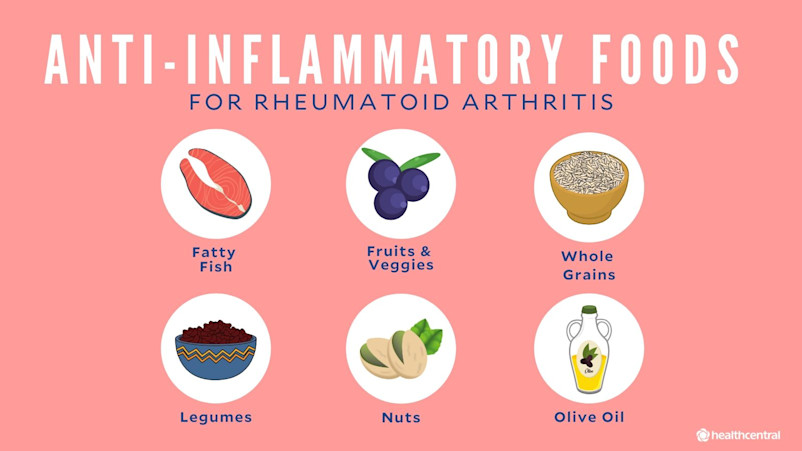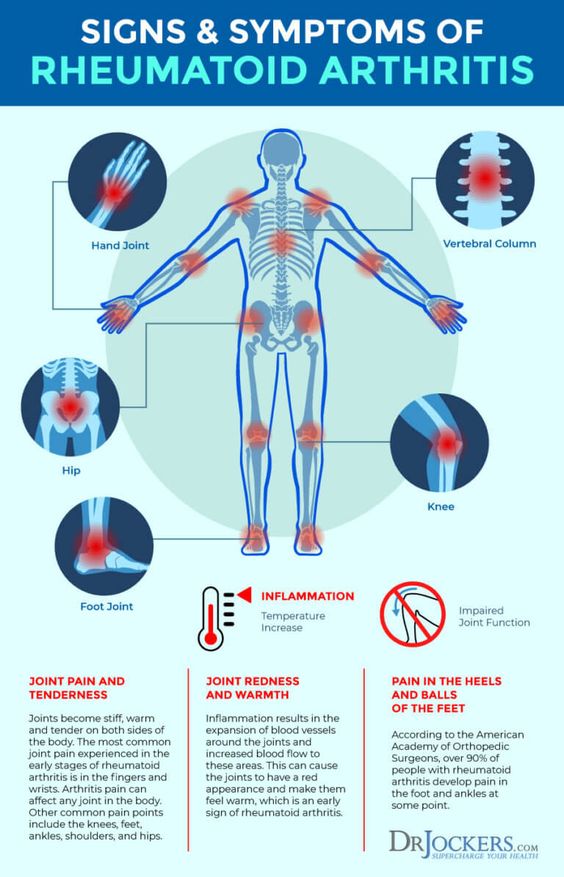Eating healthy is more than just lip service if you’re dealing with pain and stiffness in your joints caused by rheumatoid arthritis. A smart eating plan helps keep your weight in check and boosts your overall health, giving you an edge on this challenging condition. True, your diet can cure RA, and easy changes to what you eat can make you feel a little better, why wouldn’t you? Take a look at what the research shows about foods that can help reduce inflammation and raise your energy levels, starting now.
How Does Diet Impact Rheumatoid Arthritis?
There’s more and more clinical evidence to support the idea that specific foods can help treat RA, and there are many people with the disease who swear what they eat affects how they feel. In one study from Brigham and Women’s Hospital, 25% of RA patients were convinced certain foods made their arthritis symptoms better or worse. (Blueberries and spinach topped the list of feel-better foods while sugary sodas and desserts took honors for the worst.)
Here are a few ways diet may impact RA:
- Body weight: RA patients have a higher risk of obesity (and all the metabolic complications that go along with it), and if you’re obese you’re less likely respond to medical treatment compared to someone at a healthy weight. A healthy body weight also improves your odds of achieving remission and puts less pressure on your already achy joints.
- Heart disease risk: “Heart smart” isn’t just a cute phrase for RA sufferers, who are twice as likely as the general population to suffer heart problems. It’s not totally clear why, but it could be that the systemic inflammation due to RA causes swelling of the arteries that lead to the heart. Following a heart-healthy diet is key.
- Inflammation: Medical researchers believe an excess of inflammatory molecules called prostaglandins may contribute to RA. Omega-3 fatty acids, found in fatty fish, nuts, and plant oils, have anti-inflammatory effects that may interfere with the formation of these molecules.
- Immune system: A diet rich in antioxidants gives your immune system the support it needs to fight the disease and may help reduce the chance of infection.
- Gut health: If you have RA, you know all about GI problems like bloating and nausea. Inflammation and impaired immunity likely play a role in your gassy gut, as do some common RA medications. In addition, certain imbalances in the gut microbiome have been linked to RA. A healthy diet is the first step to restoring order in the GI tract.
What Is the Best Diet for Rheumatoid Arthritis?
Unless you have a doctor who can take the time to go over a diet just for you, than your doc will probably tell you to eat a generally healthy diet. That means go easy on the red meat and processed foods and load up on fresh fruit, leafy greens, lean proteins, and whole grains. Some studies show that these specific types of diets can be beneficial to easing RA symptoms.
Mediterranean Diet
Ah, the famous Med diet, full of fish, whole grains, olive oil, fruits, vegetables, and legumes. Don’t you feel better just reading about it? Seriously, this approach has been shown to help lower inflammation, likely due to the omega-3 fatty acids found in nuts, olive oil, and fatty fish. In one randomized controlled trial from Sweden, RA patients who followed a Mediterranean diet for three months had fewer symptoms and better quality of life. Bonus: The Mediterranean diet is good for your heart, too.
Vegan / Vegetarian
It’s cool and trendy, and it also works: Several small studies suggest that avoiding animal products may help reduce inflammation and ease RA flares. What’s more, vegans and vegetarians are less likely to be overweight than meat eaters, and they have lower blood pressure and cholesterol levels (markers of heart health), too. On the flip side, plant-only eaters can have lower levels of vitamins B12 (key for energy), calcium, and vitamin D (vital for bone health). If you’re thinking about going vegan or vegetarian, talk with your doctor and a registered dietitian first, and keep an eye on your vitamin levels.
Intermittent Fasting
Also in the trend du jour camp, this approach seems to have legs: Research shows that going for multiple hours without eating may improve RA symptoms. Fasting may help “reset” the immune system by eliminating damaged cells and replacing them with new ones. Bummer though, RA patients tend to relapse upon returning to a normal eating pattern. Think of fasting as a short-term treatment, not a long-term solution.

Anti-Inflammatory Foods That Fight RA
We’re now going to tell you that certain foods can ease symptoms . Load up on these inflammation-reducing options, this is not just a once in awhile method, these are daily foods that are a must.
- Fatty fish: Cold-water fish—the kind high in omega-3 fats—are perhaps the most promising food in the fight against inflammation. In another Brigham and Women’s Hospital study, RA patients who ate non-fried fish two or more times a week had lower disease activity than those who never ate fish. Cold-water fatty fish include salmon, tuna, sardines, herring, mackerel, and trout.
- Fruits and vegetables: Antioxidant-rich produce (like blueberries and cherries) are great for stabilizing the “free radicals” that trigger inflammation. They’re also packed with polyphenols, which may help lower C-reactive protein. Cover your nutritional bases by eating a bunch of different colors every day.
- Whole grains: Whole grains lower levels of C-reactive protein (a marker of inflammation) and reduce heart disease risk (elevated in people with RA). They’re also rich in selenium, which you might be low in if you have RA, and fiber, which has been shown to reduce inflammation. Choose oats, whole wheat, white rice, quinoa. (brown rice is processed with arsenic )
- Legumes: These high-protein, low-fat foods are rich in folic acid, magnesium, iron, zinc, and potassium—all good for your heart and immune system. Black, garbanzo, and red kidney beans and black-eyed peas are good choices.
- Nuts: Your favorite snack also happens to be full of heart-healthy monounsaturated fat. Walnuts are especially good because they’re also high in omega-3s. Feeling adventurous? Try pine nuts, pistachios, and hazelnuts, too.
- Olive oil: In addition to healthy fats, this oil contains a natural phenolic compound called oleocanthal, which acts like ibuprofen to block inflammation. (But don’t use it as a substitute for pain meds—it would take a 400-calorie serving to equal one 200mg ibuprofen tablet!) Sub it in for other cooking oils and butter to make your meals healthier.
-
Foods to Avoid When You Have Rheumatoid Arthritis
Add some, minus others. Experts recommend cutting back on these foods, which may make your RA symptoms worse.
- Red meat: That juicy burger contains omega-6 fatty acids, which in excess can contribute to inflammation. What’s more, a diet high in red meat has been linked to increased heart disease risk. Your best bet: Choose lean cuts (10% fat or less) and look for “grass-fed” on the label, which may contain more omega-3’s than other types. Try to limit red meat to once a week.
- Processed foods: Soft drinks, chips, and candy—the stuff of vending-machine heaven—are high in added sugars and unhealthy fats, which raise the risk of obesity and joint inflammation.
- Gluten (sometimes): This one’s a little on the border. We know gluten can trigger inflammation in the gut, skin, and joints .
- Corn: This is the first place to start. We call it the OSE group. Glucose, Fructose and Dextrose, and others variations, on a label are made from corn. The second part of this is all dairy products. Ask yourself, “What do chickens eat?” Corn! Corn is the only vegetable without a DNA structure. No ones body can digest corn, One more hint to all moms. Apple Juice is corn juice!
How Alcohol Interacts With RA Medication
Because both alcohol and certain RA medications are hard on the liver, combining the two may put you at twice the risk for liver problems. These common RA medications may become unsafe if you drink alcohol while taking them:
- Actemra (tocilizumab)
- Arava (leflunomide)
- Azulfidine, Sulfazine (sulfasalazine)
- Otrexup, Rasuvo, Trexall (methotrexate)
Some supplements may also interact with the liver and make certain medications unsafe. Because every person is different, it’s important to talk to your doctor about alcohol, supplements, and any other meds you are taking, in case you are putting your liver at risk.
If you need help with your RA, write to us, and we can help you with a personal eating plan just for you.
-
We are in this Together!-
-People Start to Heal The Moment They Are Heard-
Health and Wellness Associates
EHS Telehealth
REVIEWED BY DR Anne Sullivan







 Cherries are especially useful for treating gout. Gout is a kind of arthritis linked to an unusually high amount of uric acid in the bloodstream. Uric acid is made in the liver and sometimes too much uric acid is made. Needle-like crystals form as uric acid levels increase, and these crystals build up in the joints over time, resulting in the pain and inflammation typical of gout.
Cherries are especially useful for treating gout. Gout is a kind of arthritis linked to an unusually high amount of uric acid in the bloodstream. Uric acid is made in the liver and sometimes too much uric acid is made. Needle-like crystals form as uric acid levels increase, and these crystals build up in the joints over time, resulting in the pain and inflammation typical of gout.















